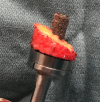Glenoid bone loss in shoulder arthroplasty: a narrative review
- PMID: 38529296
- PMCID: PMC10929280
- DOI: 10.21037/aoj-23-24
Glenoid bone loss in shoulder arthroplasty: a narrative review
Abstract
Background and objective: Crucial to the success of any total or reverse shoulder arthroplasty (RSA) is the stability of the glenoid component fixation. Instability can lead to early implant failure and unsatisfactory results. Patients often present with varying forms of glenoid bone loss (GBL) in both the primary and revision settings, which can be a challenge for the treating surgeon. Severe cases of GBL can increase the risk of potential complications and diminish implant longevity. The use of the reverse total shoulder replacement has been particularly helpful when addressing significant glenoid bony defects. Various approaches have been proposed to deal with GBL, all of which require an individualized assessment of the specifics of the defect in order to provide maximal fixation and thereby optimize the longevity of the shoulder arthroplasty. This article aims to review the recent literature on GBL in shoulder arthroplasty to provide guidance when considering treatment based on the best available evidence.
Methods: PubMed, MEDLINE, EMBASE, AccessMedicine, ClinicalKey, DynaMed, and Micromedex were queried for publications utilizing the following keywords: "glenoid bone loss" AND "glenoid bone deficiency" AND "shoulder arthroplasty" AND "classification". The search was restricted to research published between 2004 and 2023. There were no restrictions on study type or language.
Key content and findings: GBL should be critically evaluated prior to undertaking total shoulder arthroplasty (TSA). The treating surgeon should be aware of various methods of addressing bone defects.
Conclusions: The use of TSA is increasing to address various shoulder pathologies. Addressing glenoid bone defects is of critical importance to maximize the longevity and outcome of TSA.
Keywords: Glenoid bone loss (GBL); classification; glenoid bone deficiency; shoulder arthroplasty.
2024 Annals of Joint. All rights reserved.
Conflict of interest statement
Conflicts of Interest: All authors have completed the ICMJE uniform disclosure form (available at https://aoj.amegroups.com/article/view/10.21037/aoj-23-24/coif). The series “Bone Loss in Shoulder Instability and Shoulder Arthroplasty” was commissioned by the editorial office without any funding or sponsorship. The authors have no other conflicts of interest to declare.
Figures
References
-
- McGuire DT, Vrettos B, Roche S, et al. Bone loss in shoulder replacement surgery: a review of current management. SA Orthopaedic Journal 2012;11:47-55.
Publication types
LinkOut - more resources
Full Text Sources
Research Materials



